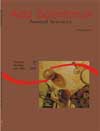<b>Effect of environmental temperature on fatty acids profile of <em>Oreochromis niloticus</em> (Nile tilapia)</b> - DOI: 10.4025/actascianimsci.v27i4.1184
Abstract
In this study the fatty acid profile in tilápia Oreochromis niloticus alevins carcass, fed with enriched diets from flaxseed oil, was examined at different temperatures (23, 26, 29 and 32oC). Tilapia in its initial phase of development did not present differences (P >0.05) on physical-chemical and lipids compositions, at the different temperatures studied. The fatty acids profile, analyzed by gas chromatography using a capillary column, showed approximately 15% of n-3 fatty acids, with values around 0.12 to 0.18% for the eicosapentaenoic acid (EPA), and from 1.21 to 2.10% for the docosahexaenoic acid (DHA). Results showed that at lower temperatures 23 and 26oC, Nile tilapia grows less than at higher temperatures around 29 and 32oC. Temperature variation from 23 to 32oC did not influence on fatty acids profile of the alevinsDownloads
Download data is not yet available.
Published
2008-03-14
How to Cite
Justi, K. C., Padre, R. das G., Hayashi, C., Martins Soares, C., Visentainer, J. V., de Souza, N. E., & Matsushita, M. (2008). <b>Effect of environmental temperature on fatty acids profile of <em>Oreochromis niloticus</em> (Nile tilapia)</b> - DOI: 10.4025/actascianimsci.v27i4.1184. Acta Scientiarum. Animal Sciences, 27(4), 529-534. https://doi.org/10.4025/actascianimsci.v27i4.1184
Issue
Section
Animal Production
DECLARATION OF ORIGINALITY AND COPYRIGHTS
- I Declare that current article is original and has not been submitted for publication, in part or in whole, to any other national or international journal.
The copyrights belong exclusively to the authors. Published content is licensed under Creative Commons Attribution 4.0 (CC BY 4.0) guidelines, which allows sharing (copy and distribution of the material in any medium or format) and adaptation (remix, transform, and build upon the material) for any purpose, even commercially, under the terms of attribution.
Read this link for further information on how to use CC BY 4.0 properly.
0.9
2019CiteScore
29th percentile
Powered by 








































